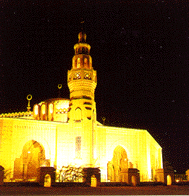
|
|
The portal conceals the inside of the building from the rest of the world and provides a threshold to what may be a very busy atmosphere outside the mosque. It preserves the tranquillity inside and so can be also be of great psychological importance to some worshippers. The area is often highly decorated, helping to make it one of the most prominent and imposing features of the mosque. A pool with or without a fountain is used for ablutions before prayer, or alternatively just for decoration. If it does have a practical use, it is usually built in the centre of the courtyard to allow the maximum number of people to wash at the same time. The area for the congregation at prayer is often partly covered by a roof and partly open to the sky. It is usually square or rectangular and may be covered by a single large dome or one or more smaller domes. The direction of prayer is indicated by the qibla wall which faces Mecca. At the mid-point of the qibla is a niche known as the mihrab. It indicates the point at which the Prophet stood when at prayer in Medina. The mihrab is the focal point of the building and is often elaborately decorated. The minbar or pulpit is to the right of the mihrab and consists of a staircase leading to small platform. It is from here that the khutba or weekly oration is delivered at Friday prayers and the idea originates from the small set of steps used by the Prophet to ensure all his followers could hear him. It's use is now essential for the imam during Friday prayers, although he speaks from the step below the platform - the highest level is reserved for the Prophet. Another platform, the dikka is reached by another set of steps and is used for the worshippers in the mosque to repeat the ritual postures of the imam and speak the responses. Nearby, stands the kursi or lectern which holds the Holy Koran. The maqsura began life in the early mosques as a raised area surrounded by wooden screens. Part of its purpose was to provide an area to safeguard the life of the imam, who was often also the local governor and therefore a target. |
JW
|

 It was not until at least the 14th or 15th Century that the minaret became a universal feature of the mosque complex, but the symbolism is more ancient. During the time of the Prophet, the call to prayer was made from the roof of his house in Medina. In days gone by, the height of the minaret over a neighbourhood has helped the sound to carry, but today, most prayer times are heralded by the sound of the call broadcast on loudspeakers. A single minaret is the norm, but some mosques do have more than one tower. The feature also provides a local landmark.
It was not until at least the 14th or 15th Century that the minaret became a universal feature of the mosque complex, but the symbolism is more ancient. During the time of the Prophet, the call to prayer was made from the roof of his house in Medina. In days gone by, the height of the minaret over a neighbourhood has helped the sound to carry, but today, most prayer times are heralded by the sound of the call broadcast on loudspeakers. A single minaret is the norm, but some mosques do have more than one tower. The feature also provides a local landmark.